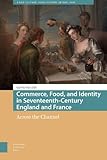Commerce, Food, and Identity in Seventeenth-Century England and France : Across the Channel / Garritt Dyk.
Material type: TextSeries: Food Culture, Food History before 1900 ; 3Publisher: Amsterdam : Amsterdam University Press, [2022]Copyright date: ©2022Description: 1 online resource (214 p.)Content type:
TextSeries: Food Culture, Food History before 1900 ; 3Publisher: Amsterdam : Amsterdam University Press, [2022]Copyright date: ©2022Description: 1 online resource (214 p.)Content type: - 9789048555161
- 641/.09032 23/eng/20220727
- TX360.F67 V36 2022
- online - DeGruyter
| Item type | Current library | Call number | URL | Status | Notes | Barcode | |
|---|---|---|---|---|---|---|---|
 eBook
eBook
|
Biblioteca "Angelicum" Pont. Univ. S.Tommaso d'Aquino Nuvola online | online - DeGruyter (Browse shelf(Opens below)) | Online access | Not for loan (Accesso limitato) | Accesso per gli utenti autorizzati / Access for authorized users | (dgr)9789048555161 |
Frontmatter -- Table of Contents -- Acknowledgements -- Introduction: The Economics of Taste -- 1. Méthode Anglaise: Transnational Exchange and the Origins of Champagne -- 2. Primary Sauces: The Rise of Cookbooks, Cuisines, and Corporations -- 3. London Coffeehouse or Parisian Café? -- 4. Sugar and Empire: Tea’s ‘Inseparable Companion’ -- Conclusion -- Bibliography -- Index
restricted access online access with authorization star
http://purl.org/coar/access_right/c_16ec
“Tell me what you eat, and I’ll tell you who you are” was the challenge issued by French gastronomist Jean Brillat-Savarin. Champagne is declared a unique emblem of French sophistication and luxury, linked to the myth of its invention by Dom Pérignon. Across the Channel, a cup of sweet tea is recognized as a quintessentially English icon, simultaneously conjuring images of empire, civility, and relentless rain that demands the sustenance and comfort that only tea can provide. How did these tastes develop in the seventeenth century? Commerce, Food, and Identity in Seventeenth-Century England and France: Across the Channel offers a compelling historical narrative of the relationship between food, national identity, and political economy in the early modern period. These mutually influential relationships are revealed through comparative and transnational analyses of effervescent wine, spices and cookbooks, the development of coffeehouses and cafés, and the ‘national sweet tooth’ in England and France.
Mode of access: Internet via World Wide Web.
In English.
Description based on online resource; title from PDF title page (publisher's Web site, viewed 29. Mai 2023)


